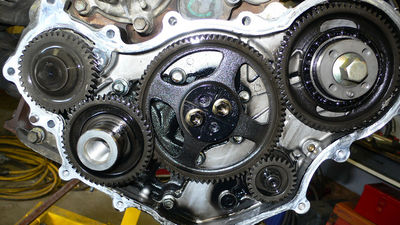How Does Changing The Size Of Gears Change The Output Of A Gear Train?

Effigy 1: A gear train [one]
A gear (also called a cogwheel) is a blazon of simple machine that is used to dispense the magnitude or direction of a force. Gears are used in combination and are linked together by their teeth - referred to as cogs - in order to form a "gear train". These gear trains are useful for transferring free energy from one part of a organization to another. Systems that utilise gears and gear trains include bicycles, cars, electrical screwdrivers, and many other common machines.[2]
How they work
Gears use the principle of mechanical advantage, which is the ratio of output force to input strength in a system. For gears, the mechanical reward is given by the gear ratio, which is the ratio of the terminal gear's speed to the initial gear'south speed in a gear train.[3] The gear ratio is given by the equation:[four]

Figure two: Animation of a gear pair, it can be seen that the smaller gear is spinning faster in order to keep up with the larger number of teeth on the bigger gear.[five]
where
- [math]North[/math] is the number of teeth on the gear,
- [math]\omega[/math] is the angular velocity of the gear and
- [math]r[/math] is the radius of the gear.
Therefore, if the mechanical advantage of a gear train is 3, that ways that the last gear in the train has a radius of 3x that of the first gear. With such a ratio, the input gear tin can be rotated with 3x less force than is output past the final gear, but in substitution information technology must exist rotating 3x faster than the final gear.
This relationship for gear trains is fundamentally dependent on the law of conservation of energy. When analyzing gear trains, this concept is more hands understood past using an analysis of the conserved power of the organisation. This analysis relates the torques of the gears to their angular velocities. A full assay of this type of substitution can exist viewed here Broken LINK.
Uses
Gears serve two principal purposes: increasing speed or increasing force. In order to increase one of these, compromises must me fabricated. For example, to increase the speed of a bicycle's wheels the force applied to the pedals must be increased. Similarly, to increase the strength on the wheels the pedals must exist turned faster. This technique is used when a rider is trying to climb a loma on a bicycle. This is all related to the conservation laws of energy and ability.
Gears are of common apply in many systems, but can most easily be recognized in everyday life in the cars we bulldoze. Cars must make use of gears in order to transfer free energy from the engine to the wheels efficiently and safely. An idling engine operates at almost 1000 rpm - if the engine was connected straight to the wheels, this would mean the car must be moving approximately 120 kph. This means if a machine's engine is turned on, it would immediately accelerate to this speed. When the engine moved into ranges with high rpm'south - around 7000 - the automobile would be going 840 kph! Although this seems very fun, it is highly impractical. This is impractical due to the fact that a car requires a large amount of energy to get moving, then an engine trying to go total speed only as it started upward wouldn't generate plenty force to move the car. Therefore the machine makes use of gears in a transmission, or alternatively a "gearbox", which starts off past using lower gears that generate more force in order to get the car moving, eventually moving up to higher gears that focus on speed.[3]
The same principle of gears applies to bicycles; going uphill requires lower gears in order to supply more force to counter the force of gravity, and once the rider is dorsum on flat country, they can switch to higher gears in club to generate more than speed for their bicycle.
For Further Reading
For further information please see the related pages below:
- Mechanical advantage
- Simple automobile
- Inclined plane
- Pulley
- Lever
- Wheel and axle
- A random page
References
- ↑ Wikimedia Commons [Online], Available: http://upload.wikimedia.org/wikipedia/commons/3/3e/1HZ-timing-gears.jpg
- ↑ HowStuffWorks, How gear ratios piece of work [Online], Bachelor: http://auto.howstuffworks.com/gears3.htm
- ↑ 3.0 3.1 Explain that stuff!, Gears [Online], Available: http://www.explainthatstuff.com/gears.html
- ↑ UCSD, Gear Ratios and Mechanical Advantage [Online], Available: http://maelabs.ucsd.edu/mae_guides/machine_design/machine_design_basics/Mech_Ad/mech_ad.htm
- ↑ Wikimedia Eatables [Online] Available: http://upload.wikimedia.org/wikipedia/commons/1/14/Gears_animation.gif
Source: https://energyeducation.ca/encyclopedia/Gear
Posted by: hutchinshisfack.blogspot.com


0 Response to "How Does Changing The Size Of Gears Change The Output Of A Gear Train?"
Post a Comment